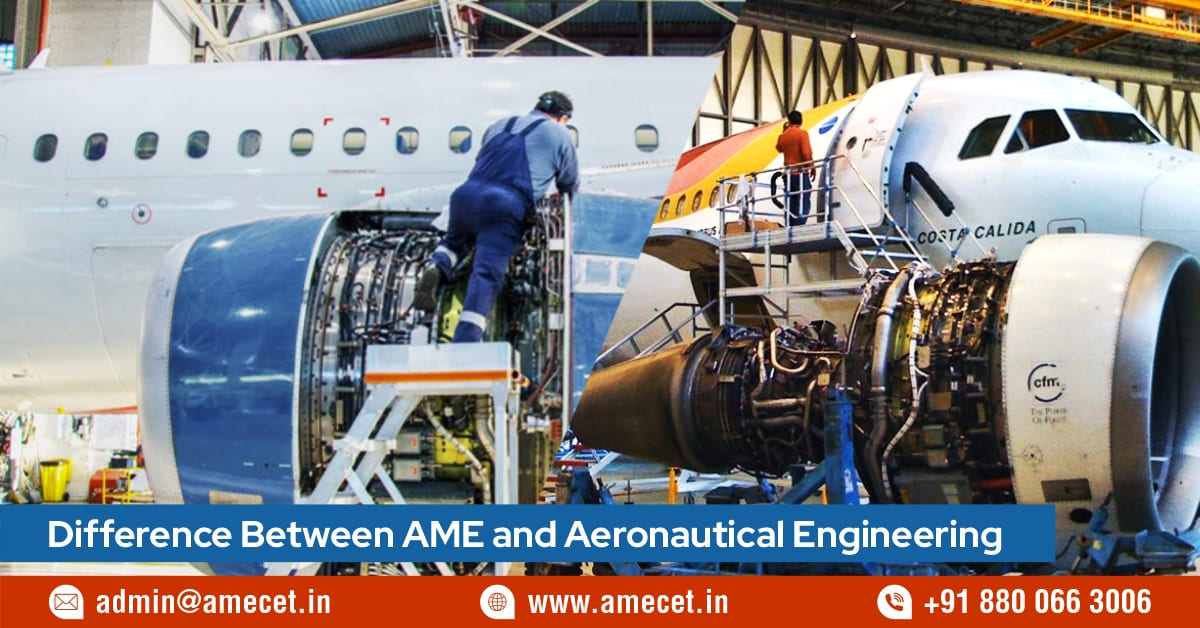Difference Between AME and Aeronautical Engineering
Posted on : 3 September, 2025 5:32 pm
Aviation is one of the most exciting career sector, and many students dream of working with aircraft. Among the popular options, Aircraft Maintenance Engineering (AME) and Aeronautical Engineering often create confusion. While both deal with aircraft, their focus, training, and career paths are very different.
Here some key differences between AME and Aeronautical:
What is Aircraft Maintenance Engineering (AME)?
- AME professionals are responsible for maintaining, repairing and overhauling aircraft, and ensuring that they are safe and airworthy. The course typically includes both theoretical and practical training, covering a wide range of topics related to aircraft systems, maintenance procedures, and regulations. In India, the Directorate General of Civil Aviation (DGCA) regulates AME programs.
What is Aeronautical Engineering?
- Aeronautical Engineering is a branch of engineering that focuses on the design, development, and testing of aircraft. Students study aerodynamics, propulsion, materials, and avionics to create advanced aircraft and space systems. It is usually a 4-year undergraduate degree (B.Tech/B.E) approved by AICTE. Aeronautical engineers mostly work in research, design, and manufacturing rather than direct aircraft maintenance.
Key Differences between AME and Aeronautical Engineering
| Factor | Aircraft Maintenance Engineering (AME) | Aeronautical Engineering |
| Objective | Ensures the safety and maintenance of aircraft | Focuses on designing and developing aircraft |
| Qualification | License-based program (DGCA/EASA/FAA) | Degree course (B.Tech/B.E) |
| Duration | 3-4 years | 4 years |
| Eligibility | 10+2 with PCM (entrance exams like AME CET) | 10+2 with PCM (entrance exams like JEE/State CETs) |
| Work Nature | Certifies aircraft airworthiness through inspections and maintenance | Designs, develops, and tests new aerospace technologies |
| Workplace | Airlines, MROs, airports, defence aviation | R&D centres, manufacturing industries, space organizations |
Career Opportunities
After AME
- Airlines (Indi Go, Air India, Emirates, etc.)
- Maintenance, Repair & Overhaul (MRO) organizations
- Aircraft manufacturing companies
- Airports and defence aviation
After Aeronautical Engineering
- Aircraft and spacecraft design companies
- R&D organizations like DRDO, ISRO, and HAL
- Aerospace manufacturing industries
- Global aviation and space research organizations
Salary Comparison
- In India, fresh AMEs earn around ₹6-10 lakhs annually, with higher salaries abroad ($60,000-$100,000 per year). Aeronautical Engineers in India earn around ₹4-8 lakhs annually at entry level, with potential growth to ₹15-20 lakhs in senior positions. Abroad, salaries range from $70,000 to $120,000 depending on experience.
Which One Should You Choose?
- If you are passionate about aircraft safety, inspections, and hands-on technical work, AME is the right choice. On the other hand, if you are interested in designing, research, and working with aerospace technologies, Aeronautical Engineering is better.
Both AME and Aeronautical Engineering play vital roles in aviation but serve different purposes. AME ensures aircraft remain safe and operational, while Aeronautical Engineering pushes innovation in design and technology. The right choice depends on your interests and career goals.

